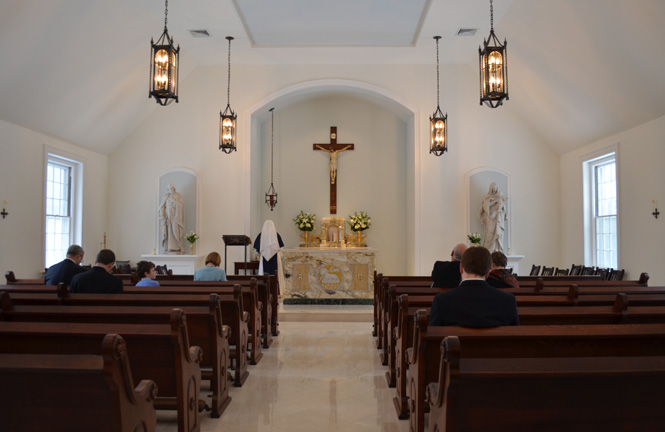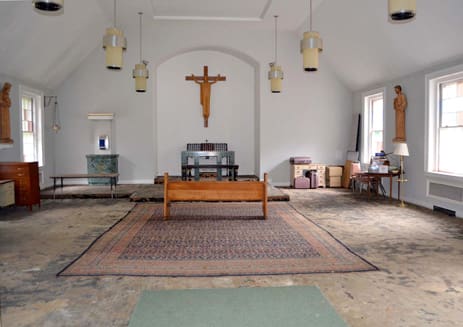Online Edition:
June-July 2013
Vol. XIX, No. 4
The Need for Beautiful Churches
— and some encouraging ideas and examples


The before (above) and after (below) views of the chapel of the Sisters of Life at their motherhouse in New York show an encouraging example of what can be done to restore beauty to our churches.
by Art Lohsen
It’s happening all over America. Pastors and dioceses are phoning to say that they need their post Vatican II church renovated to be more traditional, more beautiful, more Catholic.
Whether it is the sanctuary that houses a lonely presider’s chair instead of a crucifix and tabernacle, or the hexagonal or circular church that has neither Catholic identity nor constitutes sacred space, it is apparent there is a new wave returning to the ancient norms of the Church.
While many parishes were well-intended in their aim to fulfill an initial interpretation of the Vatican II documents, many churches were built in a manner that destroyed centuries of understanding about the impact, meaning, and sanctity of the Mass. There is actually a keen appreciation for the importance of tradition in the documents of the Second Vatican Council. Rather than calling for the wholesale rejection of the past, Sacrosanctum Concilium calls for the careful preservation of the treasury of Church art and architecture. It calls for “noble beauty rather than sumptuous display” (SC 124). Thus the importance of true beauty — as distinct from frivolous ornament — is confirmed, and it is to this true beauty that priests and parishes alike are drawn.
Beauty has been marginalized as an expensive luxury, not a vital necessity. As the appreciation of beauty faded over the last five decades, the ability to achieve it has atrophied, and pastors seeking to build a church are often told that beauty is not important, cannot be achieved on a limited budget, or that a different definition of beauty is now appropriate. Much of the Church’s patrimony has been lost or destroyed; however, the pool of classically minded architects and artists is small, but growing!
Blessed John Paul II, in his 1999 Letter to Artists, states that “In a certain sense, beauty is the visible form of the good, just as the good is the metaphysical condition of beauty” (§3). Thus the beauty that is perceived by Man’s senses is a means of physically experiencing the goodness of God. This is the foretaste of heaven, the ability to perceive in the senses as well as the mind the ultimate perfection toward which Man constantly struggles. A church building therefore must be beautiful, or it cannot provide this direct sensory and spiritual encounter with God.
True beauty can still be achieved by those who can articulate its true nature and defend its necessity in Catholic worship. While the lack of beauty in most contemporary churches is being broadly lamented, the effort to restore beauty in the Church takes patient endurance. It is possible to bridge the modern with time-honored traditions.
Beautiful churches are not only possible, they are the most responsible way to build. Given limited funds — and funds are usually limited — a church should be built to last for the long term, which means it must be aesthetically timeless as well as solidly built. There are architects and art-ists who understand this, who can work within the traditions of the Church to create beautiful churches that will meet contemporary liturgical and functional needs in a transcendent and truly sacred space.
The Church is entering an exciting period of renewal in which beauty will be increasingly appreciated and achieved.
It seems that it is now time to focus on some practical solutions to help pastors, parish committees, and diocesan officials achieve this bridge between the awkward churches they have inherited and the transcendent Catholic beauty they desire. Most priests are not skilled as facility managers, and yet are faced with enormous building challenges as they become assigned as pastors of parishes. Most pastors understand what it is they need and are willing to undertake the challenge of restoring a sense of the sacred in their churches and other buildings.
But they also need professional guidance, which takes time and money — both of which are usually in short supply. A classically trained architect understands the confluence of many characteristics including proportion, scale, symmetry, detail, material, and color. To that list, one must also add what Pope Benedict aptly deemed the “hermeneutic of continuity.” The direct and literal connections to the traditions of the Church is what a professional architect can help achieve.
Sisters of Life Chapel
An example of what can be accomplished on a modest budget and schedule is the renovation of the chapel of the motherhouse of the Sisters of Life in New York.
They had a limited budget (based on donations), little experience in construction, and only six months until their dedication Mass! They consulted with a class- ically trained architect, established their priorities, engaged Catholic community service labor; and by re-using and re-fitting architectural and decorative elements (a patrimony from local diocesan warehouses and facilities), they achieved their goal. On February 11, 2013, six months from the start of the project, Annunciation Chapel was dedicated by Cardinal Timothy Dolan.
The total cost of construction was under $150,000. Professional fees and labor, had they not been donated, would have cost about the same as construction. So, for approximately $300,000, the sisters now have a chapel that expresses a beautiful and sacred Catholic space of noble simplicity in keeping with their community way of life.
The before and after views of this chapel show an encouraging example of what can be done with the right guidance and motivation.
The architects, artists, and tradesmen who are capable of producing beautiful churches are out there, and in most cases quite busy.
The restoration of traditional Catholic beauty in our churches has become a real and growing renaissance, and it is always a joy to see the results reach fruition!
***
Art Lohsen is president and managing director of Franck & Lohsen Architects, Inc. in Washington, DC. This firm, which Mr. Lohsen co-founded in 2000, has completed a wide range of projects, ranging from large homes and historic renovations to urban planning and civic buildings. A major portion of the firm’s work has been for the Catholic Church, in the design of new churches and renovations. Learning from the precedents of history, Franck & Lohsen designs buildings that are constructed with modern materials and techniques yet are timeless and beautiful. The firm has worked throughout the United States, and has prepared designs for projects in Rome, London, and the Bahamas. Website: francklohsen.com.
Mr. Lohsen has more than 20 years of experience in design and construction, and earned his Bachelor of Science and Master’s degrees in architecture at the University of Maryland. Raised a Lutheran, he was received into the Catholic Church in 2010.
This article is reprinted with permission from the April 2013 issue of AD2000
***
*



